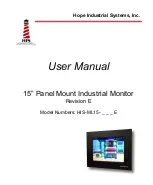
TECHNICAL MANUAL
LARGE DISPLAYS DN109/NB - DN119/NB - DN189/NB - DN129/NB
CHAPTER 26
SERIAL COMMUNICATION
26-5
Example:
To send
“HELLO” (48h 4Fh 4Ch 41h) the following frames are set:
Fig. 111: Frames sent and received to display "HELLO" by MODBUS RTU
ASCII Protocol
This protocol allows easy communication with any device that has a serial line, and the
protocol can be configured, such as a computer, a PLC working in RS-232 mode, etc. Another
possibility is to connect several displays to the same RS-485 network.
With this protocol, the display works in slave mode, when receiving data, it checks if the
header and the end of the block correspond to those configured. If so, it displays the content of
the data. The frame is configurable to be able to adapt to many protocols that use the ASCII
format.
To understand how the protocol can be configured, the terms used are described below:
Transmission BLOCK
: It is made up of all the bytes necessary to display a
value. For each successfully received transmission block the display will be updated with
a new value. Each block consists of three parts: The header (Header), the data and the
end of the block (End block).
HEADER:
It is used to identify the beginning of the block. You can choose
between 6 formats or without header.
Data BLOCK
: Contains the information to be displayed. It is possible to select
the part of the block to be displayed.
END BLOCK
: It is used to identify the complete arrival of the block. You can
choose between 6 types of end block.
In addition, there are control commands that allow you to start and end the blinking of one
or more characters, as well as in displays with the color option, to set the color of the display (as
long as it does not have automatic color conditions).
08h
Start of blinking characters
09h
End of blinking characters
















































